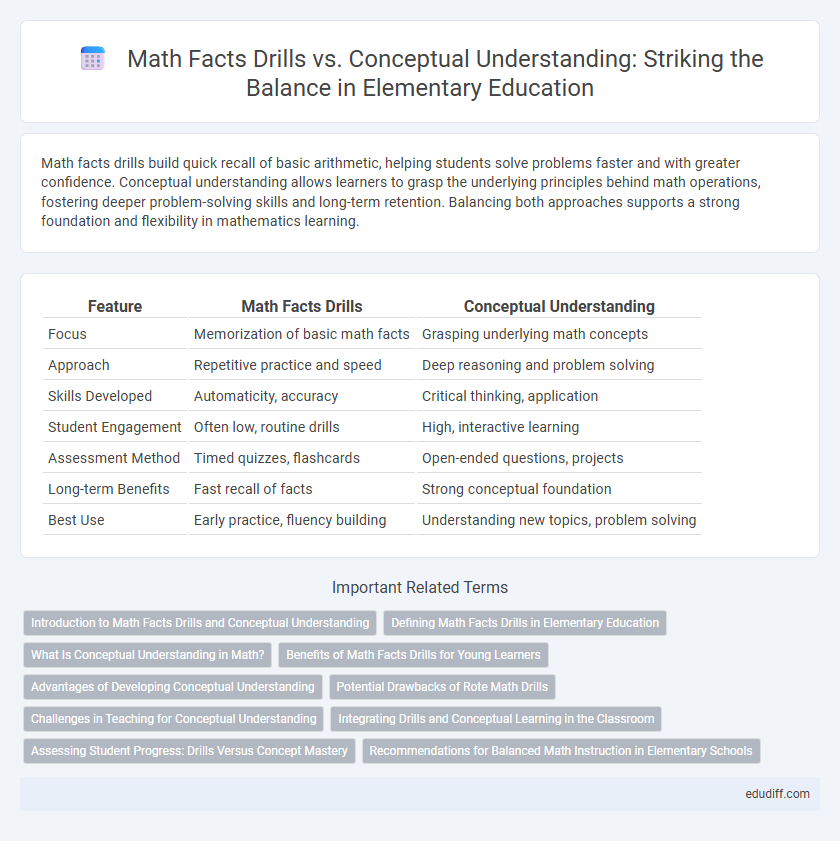Math facts drills build quick recall of basic arithmetic, helping students solve problems faster and with greater confidence. Conceptual understanding allows learners to grasp the underlying principles behind math operations, fostering deeper problem-solving skills and long-term retention. Balancing both approaches supports a strong foundation and flexibility in mathematics learning.
Table of Comparison
| Feature | Math Facts Drills | Conceptual Understanding |
|---|---|---|
| Focus | Memorization of basic math facts | Grasping underlying math concepts |
| Approach | Repetitive practice and speed | Deep reasoning and problem solving |
| Skills Developed | Automaticity, accuracy | Critical thinking, application |
| Student Engagement | Often low, routine drills | High, interactive learning |
| Assessment Method | Timed quizzes, flashcards | Open-ended questions, projects |
| Long-term Benefits | Fast recall of facts | Strong conceptual foundation |
| Best Use | Early practice, fluency building | Understanding new topics, problem solving |
Introduction to Math Facts Drills and Conceptual Understanding
Math facts drills help elementary students quickly memorize basic addition, subtraction, multiplication, and division, building fluency and automatic recall. Conceptual understanding emphasizes grasping the 'why' behind math operations, promoting deeper comprehension and problem-solving skills. Combining both approaches supports balanced math learning, enabling students to apply facts efficiently while understanding underlying concepts.
Defining Math Facts Drills in Elementary Education
Math facts drills in elementary education emphasize repetitive practice of basic arithmetic operations such as addition, subtraction, multiplication, and division to build quick recall and automaticity. This method helps young learners achieve fluency by reinforcing memorization of number combinations, which supports faster problem-solving in more complex math tasks. Developing strong math fact fluency through drills provides a foundation that enables students to focus on higher-order thinking and conceptual understanding later.
What Is Conceptual Understanding in Math?
Conceptual understanding in math involves grasping the underlying principles and relationships between mathematical ideas rather than merely memorizing facts or procedures. It enables students to apply knowledge flexibly to solve novel problems and make connections across different math topics. Developing conceptual understanding supports deeper learning and long-term retention compared to repetitive math facts drills.
Benefits of Math Facts Drills for Young Learners
Math facts drills build automaticity in young learners, allowing quicker recall of addition, subtraction, multiplication, and division facts, which supports efficient problem-solving. These drills enhance working memory by reinforcing number patterns and relationships through repetition, making complex calculations easier. Mastery of basic math facts reduces cognitive load, enabling students to focus on higher-level math concepts and reasoning.
Advantages of Developing Conceptual Understanding
Developing conceptual understanding in elementary math fosters long-term retention and flexible problem-solving skills, enabling students to grasp underlying principles instead of merely memorizing facts. This approach enhances critical thinking and supports the ability to apply knowledge to new and varied mathematical situations. Conceptual understanding also builds a stronger foundation for advanced math topics and reduces frustration by promoting meaningful learning experiences.
Potential Drawbacks of Rote Math Drills
Rote math drills often lead to superficial memorization without deep comprehension, causing students to struggle with applying concepts to new problems. This method may hinder the development of critical thinking skills and conceptual understanding essential for higher-level math. Overreliance on drills can also reduce student engagement and limit opportunities for meaningful problem-solving experiences.
Challenges in Teaching for Conceptual Understanding
Teaching conceptual understanding in elementary math faces challenges such as students struggling to grasp underlying principles beyond memorizing math facts, which often leads to gaps in problem-solving skills. Traditional math fact drills emphasize speed and accuracy but can overshadow deep comprehension of mathematical concepts. Educators must balance reinforcing math fact fluency with interactive techniques that promote conceptual reasoning and critical thinking to enhance long-term learning outcomes.
Integrating Drills and Conceptual Learning in the Classroom
Integrating math facts drills with conceptual understanding enhances elementary students' numerical fluency and critical thinking skills. Structured practice of basic arithmetic facts builds speed and accuracy, while conceptual learning fosters deeper comprehension of mathematical principles. Combining these approaches in classroom instruction supports balanced math proficiency and long-term retention.
Assessing Student Progress: Drills Versus Concept Mastery
Math facts drills improve speed and accuracy in basic calculations, providing quick assessment data on student proficiency with number recall. Conceptual understanding allows students to demonstrate deeper reasoning and problem-solving skills, offering insight into their ability to apply math principles in various contexts. Assessing progress requires balancing timed drills for fluency with open-ended tasks that measure mastery of underlying mathematical concepts.
Recommendations for Balanced Math Instruction in Elementary Schools
Effective elementary math instruction combines math facts drills with conceptual understanding to build fluency and deep comprehension. Incorporate timed practice for addition, subtraction, multiplication, and division alongside activities that explore number relationships and problem-solving strategies. Teachers should use assessments to tailor instruction, ensuring students develop automatic recall of math facts while grasping the underlying concepts.
Math Facts Drills vs Conceptual Understanding Infographic

 edudiff.com
edudiff.com